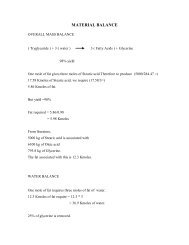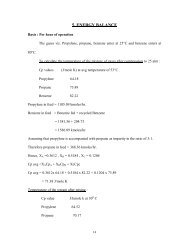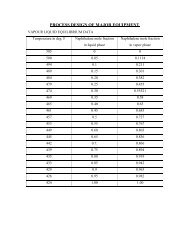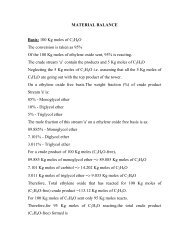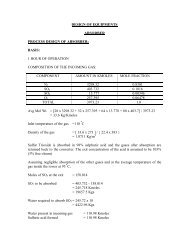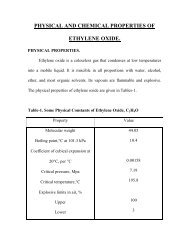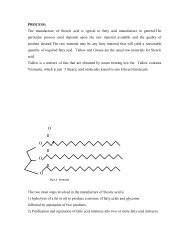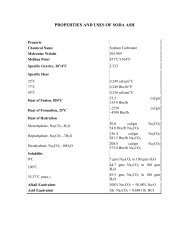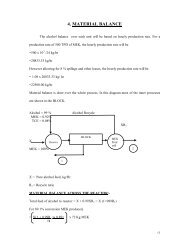Terephthalic acid Methods of Production
Terephthalic acid Methods of Production
Terephthalic acid Methods of Production
You also want an ePaper? Increase the reach of your titles
YUMPU automatically turns print PDFs into web optimized ePapers that Google loves.
Reactor Unit:<br />
The reactor unit comprises <strong>of</strong> a reactor, a condenser and a G-L separator. The raw<br />
materials p-Xylene, air, acetic <strong>acid</strong> (solvent) and the catalyst (cobalt) are fed continuously<br />
into the reactor. The reactor is maintained at a temperature <strong>of</strong> 150ºC and a pressure <strong>of</strong><br />
1500 kPa – 3000kPa. The air is added in greater stoichiometric ratio to minimize the<br />
formation <strong>of</strong> byproducts. The heat <strong>of</strong> reaction is removed by condensing and refluxing<br />
acetic <strong>acid</strong>. The reflux stream passes through the G-L separator where the excess air is<br />
removed and the liquid refluxed back into the reactor. The residence time <strong>of</strong> this reaction<br />
varies from 30 minutes to 3 hours. More than 95% <strong>of</strong> p-Xylene is converted to product.<br />
The outlet from the reactor is a slurry, since it is soluble to a limited extent in the solvent<br />
used.<br />
Separation And Drying Unit:<br />
The separation and drying unit consists <strong>of</strong> a surge vessel, a centrifuge and a rotary drier.<br />
The surge vessel is maintained at a low temperature and pressure when compared to the<br />
reactor. The cooled slurry from the surge vessel is fed to a centrifuge. In the centrifuge<br />
most <strong>of</strong> the water content is removed from the product (<strong>Terephthalic</strong> <strong>acid</strong>). There are two<br />
streams leaving the centrifuge. One stream is sent to the recovery unit. And the other is<br />
sent to the rotary drier. The solid stream is sent to the drier. Preheated air is sent to the<br />
through the drier to remove the moisture present in the final product. The product from<br />
the drier is 99% pure <strong>Terephthalic</strong> <strong>acid</strong>.<br />
Recovery Unit:<br />
The recovery unit comprises <strong>of</strong> two set <strong>of</strong> distillation columns, condensers and reboiler.<br />
The mother liquor from the centrifuge consists <strong>of</strong> three components p-Xylene<br />
(unreacted), catalyst, Acetic <strong>acid</strong> and water. This stream is fed to the residue still. The<br />
residue from the still contains acetic <strong>acid</strong>, p-xylene , water and the catalyst. The catalyst<br />
can be recovered from this residue. The distillate from the still has trace amount <strong>of</strong> p-<br />
Xylene, acetic <strong>acid</strong> and water. This is fed to a dehydration tower where the water is<br />
removed from acetic <strong>acid</strong>. Acetic <strong>acid</strong> is recycled back to the reactor in addition with a<br />
makeup acetic <strong>acid</strong> stream.<br />
The process flow diagram is as shown below




